
Close-up of the
first planet photographed outside our solar system
The following
information has been supplied by Ronald Nussbeck
BEYOND HUBBLE'S VISION NEW SOLAR SYSTEM FOUND
(PHOTOS)
A scientific breakthrough in Optical
science came in 2003 with the invention of APEP-
Advanced Photographic Extraction Process. Since
2003, inventor Ron Stewart has made several ongoing
improvements, making APEP applicable in other ways
as well, such as: Sonar Imaging, Ground Penetrating
Radar, Infra-red Imaging, X-Ray Imaging, Digital
Photographic Imaging and astrophotography.
APEP MORE EASILY UNDERSTOOD
APEP (aka PPP-Penetrating Photographic
Process), what does it stand for and how may it
be more readily understood ? APEP means; (ADVANCED-PHOTO-EXTRACTION-PROCESS).
Or simply a new photo technique process, that can
extract very small pieces of an image out of a photo,
and present that in a series of enlarged enhancements.
The first step in extracting images from a photo
by APEP, that cannot be seen with the naked eye
or any other process, is to take a color photo that
has as little as 100 DPI and transform it into a
black and white image, and increasing the concentration
of DPI to 1200.
The second step is to take the black and white photo
which now has 1200 DPI and enhance the image again
until the image has a total concentration of about
4800 to 6000 DPI, bringing the image to the maximum
resolution under the laws of physics.
Using old photos that were taken before digital
cameras were invented had round pixels which only
allowed about a 1/4 to 1/2 of all imaged data to
be processed within the image itself. Digital is
based upon a square image concept which allows less
space between each pixel of data. Because the space
is lessened between a round pixel and a square one,
more data ise allowed to be brought out in a digital
photo.
APEP basically is a "Square-pixel" In
theory the pixel is somewhat pulled together, it's
like tightening your belt around your waist, this
"may" in theory add a little more room
for extra data to reveal itself. Especially when
under such high concentrations of increasing the
dpi level within the image. For example, a photo
that is photographed at 300 dpi, APEP increases
the image to 2000 dpi. The image now may in theory
transfer from 300 to a total of 2300 dpi. Each time
the process is applied, the "APEP-Belt"
is tightened until it reaches 6,000 dpi or more
"Total-dpi", then it is also as if a person
tightened the belt around your waist so tight you
cannot tighten it anymore. So it is with APEP, no
more resolution can be obtained out of the photo,
under the laws of physics.
APEP is looking towards the future with an upgrade
to HD (High Definition) imaging that the inventor
Ron Stewart believes could increase the power of
the system by 500% or to 30,000 dpi. This upgrade
will require an investment in new hardware equipment
development and image processing technics, and is
months away from completion but will revolutionize
the imaging industry.
APEP has been used in some Archeology digs around
the world and under water to deliver a clear picture
of what is under the water or below the sea bed.
Now APEP has turned it's attention to SPACE with
results beyond the inventors dreams, some photos
reveal never before seen images.
I have equated the importance of this invention
to that of the Radio Telescope, unlocking doors
that were never thought possible for hundreds of
years, prior to using optical telescopes. Optical
telescopes which gather and focus light from visible
parts of the electromagnetic spectrum for viewing
magnified images for photographs or data of electronic
image sensors. With three primary types of optical
telescopes, Refractors (Dioptrics) which use lenses,
Reflectors (Catoptrics) which use mirrors and Combined
Lens-Mirror Systems (Catadioptrics) which use lenses
and mirrors in combinations.
APEP uses colors in combination with black and white
imagery like the Catadioptrics system to produce
enhanced photographic imagery that otherwise could
not have been seen in a photo, video or digital
image. Most everyone has heard of the Hubble Space
Telescope, it is now possible to enlarge and enhance
photos from Hubble's space telescope many times
over existing technology, not only showing a solar
system outside our own, but the planet up close.
The inventor believes it may be possible to view
the surface of the planet for signs of life and
large bodies of water that Hubble could never retrieve
without the use of APEP. Currently, APEP is making
available HD High Definition patent license agreements
to Astrophysicist, Universities and Observatories
around the world on a limited scale. To reserve
a license for APEP PLANET HUNTER TECHNOLGY LICENSE
contact rnsuitcase@aol.com
The fact is, APEP can be used for space and underwater
enhanced imagery, by producing clear photos of objects
under the water that before now were either too
dark or murky to see. APEP has solved this problem,
the ability to extract clear photographic images
from underwater is one of APEP's many super powers
and can transfer to other applications. Here is
a link to NASA images of the Universe
http://www.google.com/search?hl=en&q=nasa+images&aq=2&oq=NASA&rlz=1W1GZEZ_en-GB
NASA's use of Hubble's space based telescope has
given incredible images but now APEP will take some
of those images and display it's SUPER POWERS for
the world to see for the first time. Ron Stewart,
who invented and patented APEP, would like to invite
NASA to investigate as to what kind of potential
APEP may have in space exploration, including his
discovery of a new solar system in Orion Nebula
M 42 with planets that revolve around a sun like
our own solar system. APEP can leap forward planet
finding by perhaps generations, giving scientists
an opportunity to find life beyond our own solar
system.
Examples of Artifact Misrepresentation/Random-Pixels
; Compared To APEP
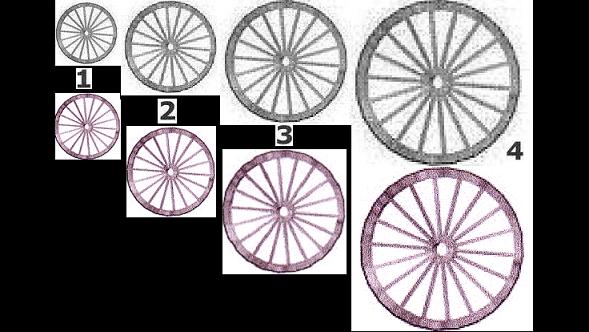
The Wagon wheel at top with JPG
artifacts and APEP comparison Wagon wheel below
without JPG artifact. Conventional methods of enlarging
objects lead to artifacts in JEP compression format,
but clearly you can see APEP leaves no artifacts
when enlarging, without losing definition, clarity
and resolution. The first image starts to pixilate
causing a more cluttered look and gives artifact
misrepresentations to the image losing valuable
Mega byte information.
BEYOND HUBBLE'S VISION ARE STELLAR
FORMATIONS WITH SOLAR SYSTEMS
APEP has found a Solar system at the
center of the Orion Nebula M 42 A in the 2.5 light
year wide area with 1 protoplanetary disk or proplyd,
which is believed to be embryonic solar systems
that form planets. NASA's Hubble Space telescope
is a genius of scientific accomplishment and it
is an honor to credit NASA with these outstanding
photos.
The Orion Nebula is one of the most scrutinized
and photographed objects in the night sky, and among
the most intensely studied celestial bodies. The
Nebula has revealed the process of how stars and
planetary systems are formed from collapsing clouds
of gas and dust. APEP now takes you beyond the Hubble
telescopes vision to view a new star's birth along
with at least one of its planets, these amazing
photos (never before seen) of a solar system outside
our own. The image taken by Hubble of the Orion
Nebula, which is estimated to be 1500 light years
from earth and 24 light years across, may offer
the best possibility for viewing newly formed planets.
Spectroscopy done by William Huggins showed the
gaseous nature of the nebula in 1865. Henry Drager
took the first Astrophoto of the Orion Nebula in
1880 and is credited with being the first instance
of deep sky astrophotography. For the first time
this stellar nursery has been observed up close
revealing the recent birth of a star and an orbiting
planet by APEP. Hubble's space telescope has given
the world photos beyond anything man has seen to
this point, but APEP has gone one step further bringing
the Nebula up close for inspection. The photos provided
by APEP will give you a close up view of this new
born star and its planet, Observatories and Scientists
may contact Ron Stewart at rsmty@gvec.net
With all due respect to NASA and this formidable
space telescopes accomplishments, APEP would now
like to take you on a new space exploration adventure,
enjoy the photos. Quote from Ron Stewart, "information
may be infinitely small, but is not lost".
**The following
NASA photo of the Orion Nebula (1) was taken by
the Hubble Space Telescope**
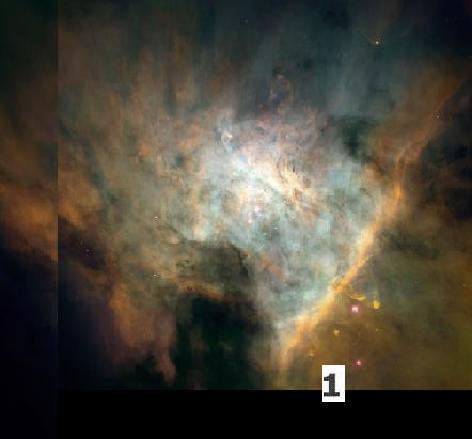
Above the number 1 and to the
right are two stars glowing red, the top star has
a yellow gas cloud above it, we will give a close
up of this massive star and go beyond to a newly
formed solar system with a planetary body orbiting
a Red Sun.
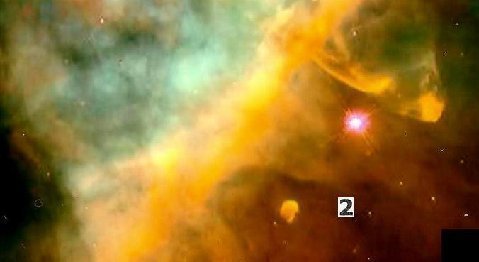
The star above the number 2 burns
bright but we turn our attention to the third dot
from the bottom right corner, just above the number
2 and to the right, APEP finds a planetary solar
system.
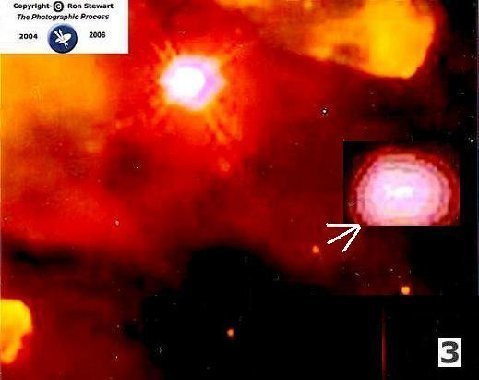
The white arrow points to the
Red Star and it's planetary solar system targeted
by APEP
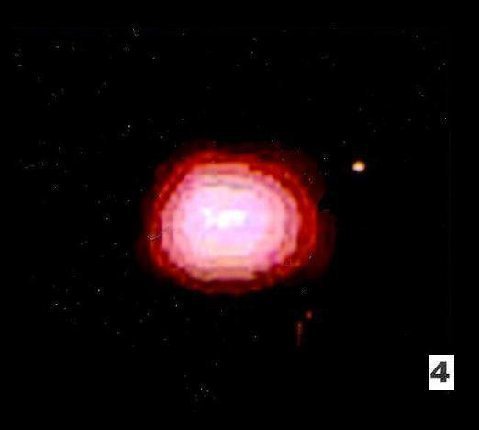
The Red Star with a gas giant
locked into orbit just beyond is one of what is
believed to be many planets in this solar system.
APEP is a planet finding process that will leap
mankind forward in the discovery of planetary bodies
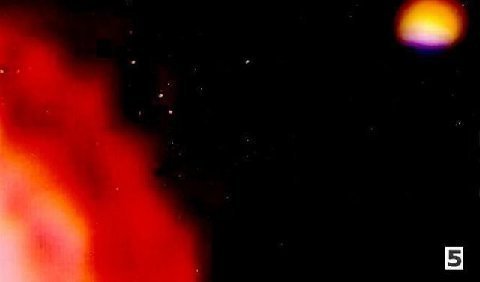
This close up view looks past
what is thought to be a Red Star with a gas giant
in the background as the first planet photographed
outside our solar system.

